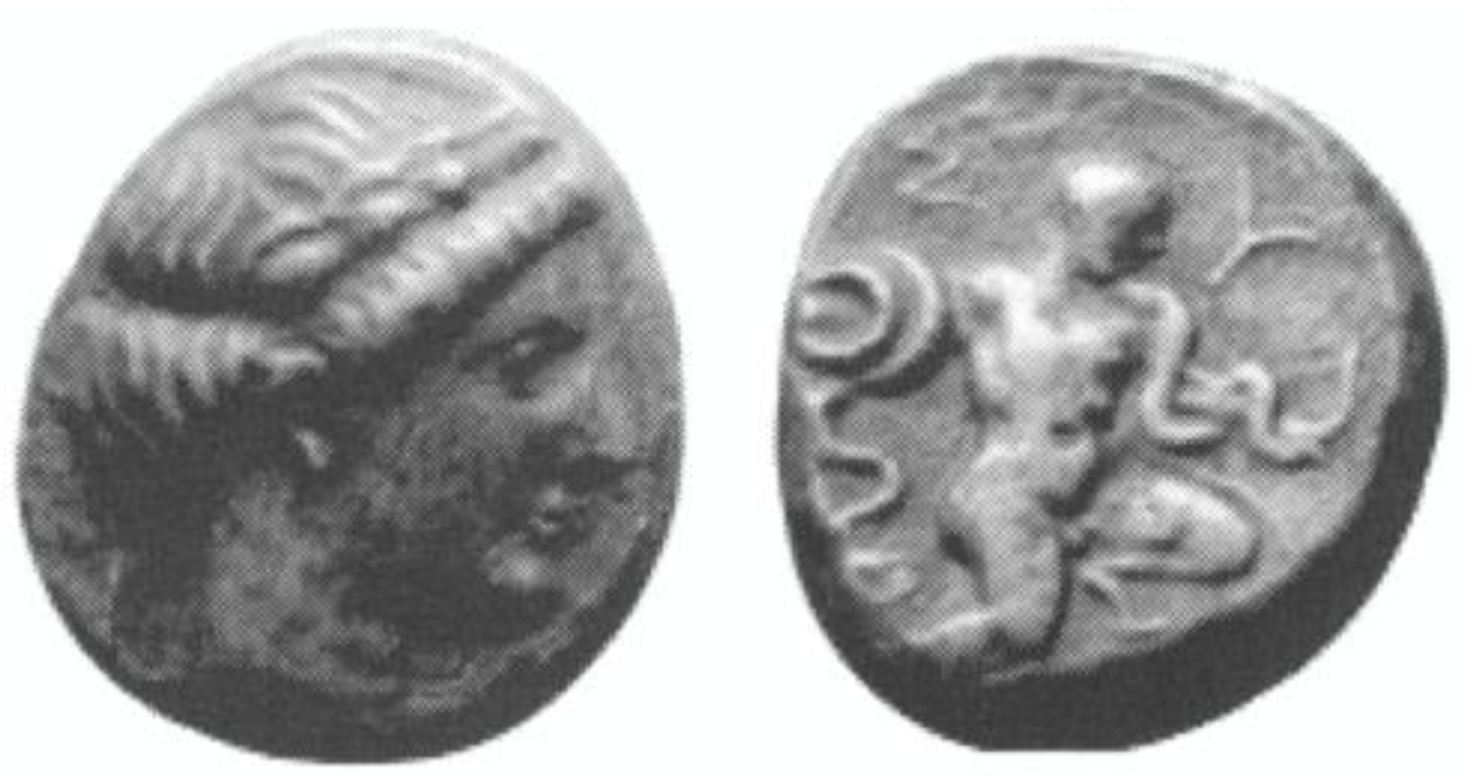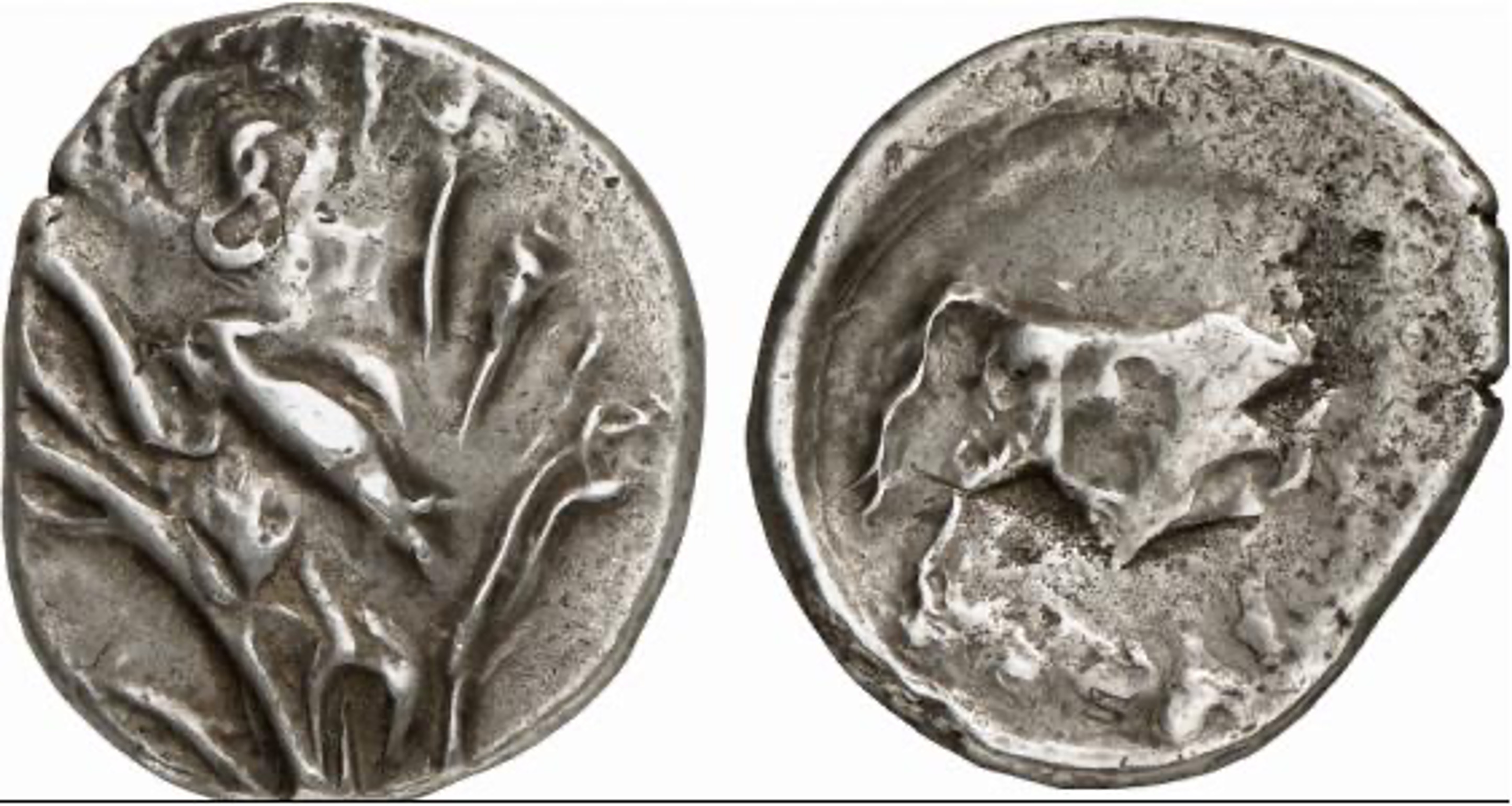2057 - Gortyn (stater Europa/bull) over Iasus (Apollo/Heracles) (Künker, 136, March 2008, 72)
From SILVER
Revision as of 16:37, 17 July 2023 by Sonia Hanczack (talk | contribs)
330 BCE - 270 BCE
Images
Overstruck variety

Iasus_Apollo_Heracles.png [1]
Location/history
| Sale(s)Sale(s) ᵖ: | Künker, 136, 10 March 2008, 72 ; Hirsch Nachf. 196, München (1997), 269 | |
| Archaeological contextArchaeological context: | IGCH 152 (Phaistos 1953), n° 119 |
Overstriking coin
Description
| ObverseInscription or printing placed on the obverse.: | Female godess, nude to the waist, seated facing in tree | ReverseInscription or printing placed on the reverse.: | Bull right, head reverted. |
Mint and issuing power
| MintIdentifies the place of manufacture or issue of a numismatic object.: | Gortyna | Ancient regionAncient region. | Crete | Modern countryModern country: Greece | AuthorityIdentifies the issuing power. The authority can be "pretended" when the name or the portrait of X is on the coin but he/she was not the issuing power. It can also be "uncertain" when there is no mention of X on the coin but he/she was the issuing power according to the historical sources: |
Chronology
| FromIdentifies the initial date in a range assigned in a numismatic context. 330 BCE toIdentifies the final date in a range assigned in a numismatic context.. 270 BCE | Hellenistic 323-30 BC |
Physical description
| MetalThe physical material (usually metal) from which an object is made.: Silver |
WeightWeight of the numismatic object (in grams). in grams: 11.6211.62 g <br />11,620 mg <br /> | DenominationTerm indicating the value of a numismatic object. Examples: tetradrachm, chalkous, denarius.: didrachm |
|
References
| Coin referenceReference of the Coin: | Le Rider 1966, p. 73, n° 44a, pl. XVII, no. 7. | Coin series referenceReference to coin series study: | Le Rider 19661Le Rider 1966, p. 73-5, n° 43-8 |
| Coin series web referenceCoin series web references: | |||
Overstruck type
Description
| ObverseInscription or printing placed on the obverse.: | Head of Apollo (visible on obverse: part of snake, legs of Heracles) | ReverseInscription or printing placed on the reverse.: | Heracles as an infant kneeling, strangling serpents (visible on reverse: head of Apollo) |
Mint and issuing power
| MintIdentifies the place of manufacture or issue of a numismatic object. ᵖ: | Iasus | Ancient regionAncient region. ᵖ | Caria | Modern countryModern country: Turkey | AuthorityIdentifies the authority in whose name (explicitly or implicitly) a numismatic object was issued. ᵖ: |
Chronology
| FromIdentifies the initial date in a range assigned in a numismatic context. 405 BCE toIdentifies the final date in a range assigned in a numismatic context.. 400 BCE | Classical 480-323 BC |
Physical description
| DenominationTerm indicating the value of a numismatic object. Examples: tetradrachm, chalkous, denarius. ᵖ: | didrachm |
References
| Coin type referenceReference to coin series study ᵖ: | Babelon 19012Babelon 1901, pl. 146, 25, Ashton 20073Ashton 2007, pl. 7, 7-8 | ||
| Coin series web reference overstruckCoin series web references overstruck: | |||
Additional data
| Frequency of overstrikesFrequency of overstrikes: | Level of confidenceLevel of confidence of the identification: | ||
| RemarksRemarks: | |||
References
- ^ Le Rider, Georges (1966), Monnaies crétoises du Ve au Ier siècle av. J.-C., Paris, Geuthner, 345 p. and 42 pl.
- ^ Babelon, Ernest (1901), Traité des monnaies grecques et romaines. Tome Premier. Première partie, théorie et doctrine, Paris, E. Leroux
- ^ Ashton, Richard (2007), "The pre-Imperial Coinage of Iasos", Numismatic Chronicle, 167, p. 47-78
